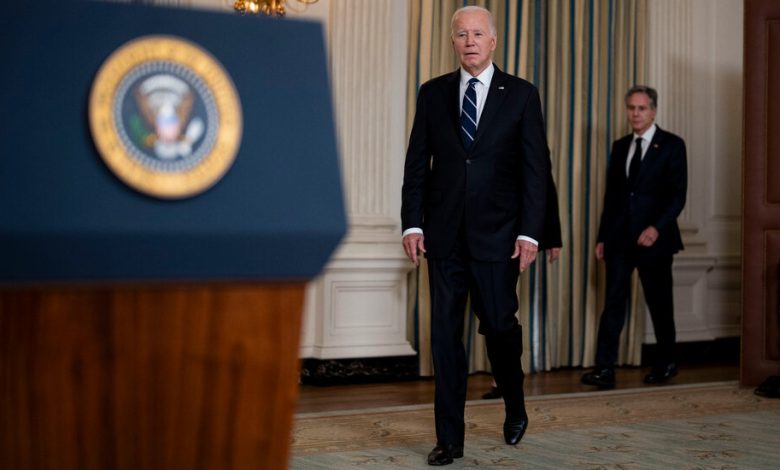How Israel’s 9/11 Tests American Grand Strategy

Twenty-one years ago, in the shadow of the Sept. 11 attacks, George W. Bush warned of an “axis of evil,” encompassing the authoritarian and anti-American regimes of Iraq, Iran and North Korea. He did not claim that they were actually allies or partners in the style of Nazi Germany and imperial Japan. What made them an axis, in his rhetoric, was simply their ample cruelty, their shared pursuit of weapons of mass destruction and their potential willingness to share such weapons with groups like Al Qaeda.
The Bush address was a classic post-9/11 speech, inflating the real dangers of pariah regimes via a dubious World War II analogy, forced through with bluster rather than defended by specifics. Many members of Bush’s team had spent their formative years focused on great power competition, and they preferred to conceptualize the war on terrorism in terms of enemy regimes that could be coerced or changed. This didn’t really make sense; there wasn’t actually an axis of culpable state actors for us to go to war with after Sept. 11. But the desire for one, the imagining of one, helps explain how Al Qaeda’s attacks led to our disastrous invasion of Saddam Hussein’s Iraq.
Two decades onward, we can see that in this great squandering of American power, our leaders helped create in 2023 the kind of landscape that Bush imagined facing back in 2002. The 9/11 attacks did not reveal a world where the Pax Americana faced serious threats from rival powers. But the world of last week’s Hamas attacks, an equivalent trauma (at least) to Sept. 11 for the State of Israel, is very different: From the American perspective, the crisis in the Holy Land must be analyzed in terms of great power politics and the pressure we face from broadly aligned rivals — Iran, Russia and China — on three fronts at once.
To be clear, we do not know yet whether the Hamas attacks were planned with Tehran’s blessing or connivance. But the fact that Iranians have in recent years increased funding and support for Hamas means that the attacks flowed in some way from Tehran’s grand strategy — its desire to surround Israel with enemies, to extend its power through allies and proxies and to disrupt the American attempt to mediate a rapprochement between Israel and the Sunni Arab states.
And this Iranian strategy, in turn, without being explicitly conceived in concert with Moscow and Beijing, functionally aligns with those regimes’ ambitions in Ukraine and toward Taiwan.
In each case there is a hostile focus on a territory perceived to be a satellite or outpost of the American empire, occupying a crucial but ambiguous place in our imperium — outside our core alliances, the “outer empire” of NATO and our formal allies on the Pacific Rim, but with intense American investment in its fate. In each case there is a desire to humble, defeat or conquer that territory not only for its own sake (Hamas clearly hates Jews much more than Iran hates Americans, and Beijing would want Taiwan back even without its rivalry with the United States) but also for the sake of revising the regional or global status quo.
Is this alignment an actual axis? Not necessarily: To be broadly aligned is not to be perfectly in sync, and our three rivals are not enacting an anti-American master plan. Rather, they are behaving as you would expect revisionist powers facing a declining but still potent hegemon — each trying to weaken the hegemon in their respective theaters, each trying to draw benefits from the hegemon’s preoccupation with other crises.
But a tacit alignment is threat enough, and it means that the United States can’t consider its approach to any one challenge without considering how it interacts with our ability to manage threats in other theaters. The understandable maximalism of Ukrainians, now joined by the understandable fury of Israelis, cannot be the only guide to U.S. policy. If we want the world system we’ve built to stand up to challenges from its enemies, we need to make sure we don’t accidentally cede Taiwan while we try to defend Kyiv and support Tel Aviv.
This is different from the hawkish perspective that sees our rivals aligning and wants to rush ahead to 1941, fast-forwarding the 1930s, dismissing any caution or realpolitik as simple appeasement. Because each of our rivals alone is still weaker than us — Russia struggling to defeat Ukraine, Iran fearful of Saudi-Israeli cooperation, China busy alienating its neighbors — we can hope to find ways to restrain each of them short of annihilatory war. Because they are not fully unified, we can hope for divisions in their interests and their strategies. (In a similar way, if Iran feels pressured to distance itself from its Palestinian allies after these atrocities, good.) And because we are still the hegemon, we have a great deal to lose from aggressive actions that court chaos, as opposed to careful measures that stabilize our imperium’s peripheries.
Talk of the nightmare that just unfolded as “Israel’s 9/11” should hammer home this last reality. The original Sept. 11 yielded an American response that was initially proportionate and effective but soon metastasized disastrously; it may not have been the kind of crumpling that Osama bin Laden overconfidently anticipated, but it was corrosive and empire-weakening nonetheless.
After that weakening, that overstretch, Joe Biden’s America now finds itself facing a more serious alignment of major-power foes than did our empire under Bush. Which makes it essential that we figure out how to pursue today’s more defensive objectives — the independence of Ukraine, the support of Israel, the preservation of Taiwan — through means that are more conservative than the ones the Bush administration embraced 20 years ago. And it’s crucial that we help our friends and allies, in their own moments of anguish and devastation, to make strategy more coolly than we did.
The Times is committed to publishing a diversity of letters to the editor. We’d like to hear what you think about this or any of our articles. Here are some tips. And here’s our email: [email protected].
Follow The New York Times Opinion section on Facebook, Twitter (@NYTOpinion) and Instagram.




